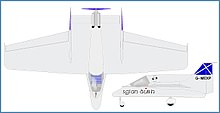Putilov Stal-5
| Putilov Stal 5 | |
|---|---|

|
|
| Type: | Transport plane |
| Design country: | |
| Manufacturer: | |
| First flight: |
1935 |
The Putilow Stal-5 ( Russian Путилов Сталь-5 , also: Stahl-5) was a transport aircraft project that was designed in the Soviet Union from 1933 . In 1933, Alexander Ivanovich Putilov began designing a flying wing passenger aircraft that was supposed to achieve maximum efficiency.
construction
The wide rectangular middle section housed the cabin and a fully glazed cockpit. The wing center section was profiled with an S-flap profile and the elevator was located on the trailing edge . The center wing was limited by the motor nacelles and fins, which ended in the rudder to the rear. The tapered outer wings carried the ailerons and were partially covered with fabric.
The special thing was the structure. As with the Stal-2, the structure should consist entirely of stainless steel tubes and profiles, which should then be covered with a layer of specially impregnated plywood. Test structures including a complete wing spar were built to test the new type of construction. A smaller version was built to test the flight characteristics. The aircraft, powered by two 45 HP Salmson engines, was designed by W. W. Karpow and Ja. G. Paul tested in 1935. The test flights showed poor handling and a lack of flight stability. After various changes had not led to better results, further work on this unconventional design was discontinued.
aerodynamics
Ultimately, with a flying wing it is always about using the entire aircraft to generate lift. In their book, Nickel / Wohlfahrt 1990 explicitly refer to the “golden rule of lift distribution”. This reads: "What is locally lacking in the angle of attack can be compensated for by a greater surface depth in this area". They use an example to illustrate this: on a Fauvel AV.36, a deepening of the inner wing in the elevator area would considerably reduce the deformation of the lift distribution caused by a pulled elevator. Theoretically, a design is even possible in which the lift distribution is no longer deformed at all. Recalculations of the wing shape of the Stal-5 showed that an optimal elliptical lift distribution would have been possible over a large speed range. In principle, the aerodynamic concept of the Stal-5 has been very promising.
In 1988, the Scottish amateur aircraft manufacturer Hugh Lorimer designed an ultralight aircraft with a very similar design.
Technical specifications
| Parameter | Data |
|---|---|
| crew | 2 |
| Passengers | 18th |
| length | 12.5 m |
| span | 23.0 m |
| height | |
| Wing area | ~ 120 m² |
| Wing extension | ~ 4.4 |
| Empty mass | 1672 kg |
| Max. Takeoff mass | 8000 kg |
| Top speed | |
| Service ceiling | |
| Range | |
| Engines | 2 × Mikulin AM-34 , each 820 PS (approx. 600 kW) |
See also
literature
- Bill Gunston: The Osprey Encyclopaedia of Russian Aircraft 1875-1995 . London, Osprey. 1995. ISBN 1-85532-405-9
- Karl Nickel , Michael Wohlfahrt: Tailless Airplanes. Their design and properties. Birkhäuser Verlag, Basel et al. 1990, ISBN 3-7643-2502-X ( flight technology series 3). Comprehensive textbook covering all types of flying wings.
